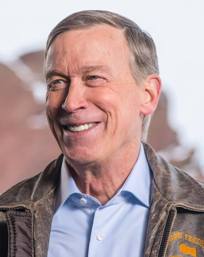Hickenlooper’s Unusual 2020 US Senate Run
Only one (non-U.S. Senator) presidential candidate has ended the bid to run for the U.S. Senate in the same cycle since 1972

Hickenlooper has not committed to a U.S. Senate campaign, but has definitely not ruled it out.
While the filing deadline is seven months away (March 17, 2020), even if Hickenlooper announces such a campaign relatively soon, the time has likely passed for him to have a field-clearing impact on the Democratic field with so many bona fide candidates already in the race.
With all the speculation in recent weeks, a Hickenlooper run for the U.S. Senate may not be seen as surprising, but historically it would be extremely unusual.
Over the 12 previous presidential election cycles during the modern primary era (1972-), only one of the dozens of White House hopefuls who were not already members of the U.S. Senate dropped out of the race to seek a senate seat in that same cycle – Virginia Republican Jim Gilmore.
[This report obviously excludes those presidential candidates who were already members of the nation’s upper legislative chamber at the time of their White House bid, and subsequently ran for reelection – e.g. Marco Rubio in 2016].
Gilmore, a former Virginia governor, made his first of two presidential runs in 2008 – a brief 80-day campaign that ended in mid-July 2007.
Gilmore narrowly received the GOP nomination for U.S. Senate at the party convention against state Representative Bob Marshall but was then trounced in the 2008 general election – by 31.3 points to former Governor Mark Warner.
Each of the other failed presidential candidates to run for U.S. Senate waited at least two years to do so.
The most recent example is Mitt Romney – who waited six years from his second presidential campaign (2012) to run for U.S. Senate from Utah. Romney became the first such candidate to win a U.S. Senate seat in 16 years when he defeated Democratic Salt Lake City Councilwoman Jenny Wilson by 31.7 points.
Only three other failed presidential candidates went on to win a senate seat since 1972:
Duke University president and former North Carolina Governor Democrat Terry Sanford ran for the Democratic presidential nomination in 1972 and 1976. It was not until a decade later that Sanford ran for the U.S. Senate and simultaneously defeated appointed Republican Senator Jim Broyhill in 1986’s special (by 1.8 points) and general (by 3.5 points) elections.
Two other candidates waited two years after their failed 2000 White House bids to win U.S. Senate seats in 2002.
Former Tennessee Governor Lamar Alexander ran for the White House in both 1996 and 2000 and in 2002 defeated Democratic Congressman Bob Clement by 9.9 points to win Fred Thompson’s open seat.
Elizabeth Dole ran for president in 2000 and when conservative Senator Jesse Helms announced he would not seek a sixth term in 2002, Dole cruised to an easy GOP primary win and an 8.6-point victory over Erskine Bowles that November.
The vast majority of failed presidential candidates who later undertook a senate campaign were not successful – but each of them took at least two years off between bids.
- New York Republican-turned-Democrat John Lindsay (1972; eight years): The former GOP U.S. Representative and New York City mayor placed third in the 1980 Democratic primary behind Congresswoman Elizabeth Holtzman with 15.8 percent
- California Democrat-turned-Republican Sam Yorty (1972; eight years): The Los Angeles mayor ran for the Republican nomination in the 1980 cycle, losing by 11.8 points to Paul Gann. [Yorty had also run for the U.S. Senate in 1940, 1954, and 1956 as well as the presidency in 1964].
- California Democrat Jerry Brown (1976, 1980; two years): The outgoing two-term governor lost the 1982 general election to San Diego Mayor Pete Wilson by 6.8 points
- Minnesota Democrat Eugene McCarthy (1972, 1976 as an independent; six to 10 years): McCarthy failed to win back his old seat by placing second in the 1982 DFL primary – 45 points behind Mark Dayton. [McCarthy also ran for president in 1968, 1988, and 1992].
- Florida Democrat Reubin Askew (1984; four years): The former two-term governor had a short-lived 1988 U.S. Senate campaign from which he withdrew after five months
- Virginia Democrat Douglas Wilder (1992; two years): The former governor briefly ran as an independent in Virginia’s 1994 U.S. Senate race eventually won by Democratic incumbent Chuck Robb
- Minnesota Democrat Walter Mondale (1984; 18 years): Mondale replaced the deceased Paul Wellstone on the 2002 ballot but came 2.2 points shy of winning back his old seat
- Georgia Republican Herman Cain (2000; four years): The businessman followed up his short-lived first run at the White House with a second place finish in the 2004 GOP senate primary – 27.1 points behind Congressman Johnny Isakson
- Maryland Republican Alan Keyes (1996, 2000; four years): Keyes replaced disgraced investment banker-turned-teacher Jack Ryan to become the party’s 2004 nominee in Illinois, losing by 42.9 points to Barack Obama. [Keyes previously ran for the U.S. Senate from Maryland in 1988 and 1992].
- Wisconsin Republican Tommy Thompson (2008, four years): The former four-term governor’s presidential candidacy lasted only 131 days and then came up 5.6 points short in the state’s 2012 open seat race won by Congresswoman Tammy Baldwin
Hickenlooper is not the only Democrat to run for president in 2020 that some from the party would rather see running for the U.S. Senate: former Texas U.S. Representative (and 2018 U.S. Senate nominee) Beto O’Rourke and sitting Montana Governor Steve Bullock also chose to seek the presidency rather than the nation’s upper legislative chamber despite calls for the latter.
Follow Smart Politics on Twitter.
